By Jeffrey A. Rendall; photos by Scot and Charles Rendall
LA QUINTA, CA – If you ever thought building a golf course on the site of a former sod farm wouldn't constitute a major challenge, then you haven’t heard the story of how the PGA West Greg Norman Golf Course came to be.
As the name indicates, the course was designed by Australian professional golf legend Greg Norman. Opening in 1999, the Norman layout joined an already impressive stable of courses at PGA West – so there was a lot to live up to in developing a new concept.
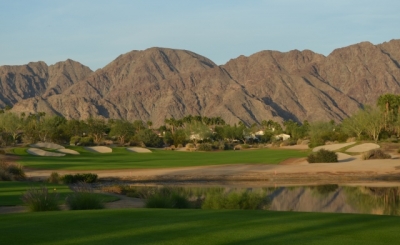 |
| Looking from the 1st tee, it is hard to believe the land used to be featureless and perfectly flat. |
Chris Campbell was the project manager for Norman at PGA West, and he explains why the site itself was the biggest obstacle to overcome in the early stages of the venture. “Obviously we had our work cut out for us from the beginning with five other great courses already being in the rotation at PGA West. But the most challenging aspect was our site, which was previously a sod farm with about two feet of elevation change from one end to the other.”
Anyone who’s been to the Coachella Valley knows the desert floor doesn’t have much variation to it. It’s basically mile upon mile of bland desert scrub and flat topography surrounded by beautiful and scenic mountain ranges.
Campbell continues, “The two most important things we knew going in were (a) we had to come up with a design concept that would set our course apart from the other courses and (b) we were going to have to move a lot of dirt and create everything from the ground up.”
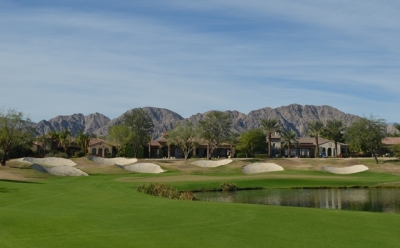 |
| Hazards await for any misses on the par five 16th hole. |
“When Greg first visited the property he came up with the idea of creating what we call an ‘outback’ design theme with minimal turf framed by drought tolerant native scrub -- reminiscent of the great courses of the sand belt of Australia like Royal Melbourne and Kingston Heath. So, our ultimate goal from that point forward was to create a course with a much more rugged character than the others at PGA West, but one that would offer both challenging and enjoyable playability, depending on the setup, for the members and resort guests.”
Having played several of the PGA West courses, I can say without equivocation that the Norman folks accomplished their mission. The Norman Course is distinctly different in its looks from the others – primarily because the amount of turf is much smaller.
That’s a little ironic – fewer acres of turf on a former turf farm. But it all goes along with the theme.
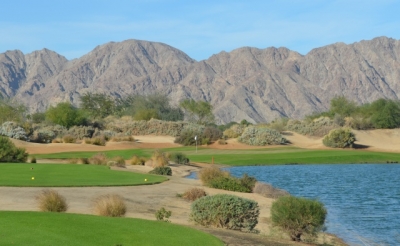 |
| Club selection is key on the par three 7th hole. |
Though there is noticeably less grass to play to, Campbell says it doesn’t necessarily make the course more difficult. “There are a few holes where minimal turf factors into the strategy, but for the most part it was just one element of our design concept that lends itself to the rugged theming of the course.”
“Water conservation was also a consideration, so we had to focus on providing enough turf in areas that are consistently ‘in-play’ and using open sand or a combination of that and drought tolerant plants and grasses to give golfers a chance to find and recover from errant shots.”
“We also tried to make the majority of the turf areas more receptive to promote playability and allow better players to use their ground game, especially when the winds get up,” Campbell added.
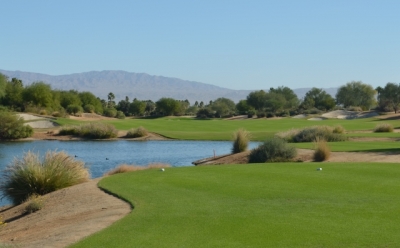 |
| A good tee shot on the par five 12th hole leaves many options for the second shot. |
Rugged indeed. Just look at the course and it’s a little intimidating. But the starter said right off that shots in the desert areas are usually findable and playable. He was right. I think we only had one or two unplayable lies during the entire round – and we were in the desert a lot!
Most of the tee views include sizable bunkers and in many cases, water. There is more than enough grassy area to play to – after all, this is a resort course – but the hazards do creep into your mind.
Campbell says it’s a delicate balance in making a course look tough but not beat up average players. “As golf course designers, any time you use a minimal turf concept with heavy landscaping and large water features you have to be very strategic with the angles you create. You’re always trying to find that perfect balance where there is a very fair option for golfers to potentially make par, but the reward of carrying a natural area or hazard just might be worth the risk.”
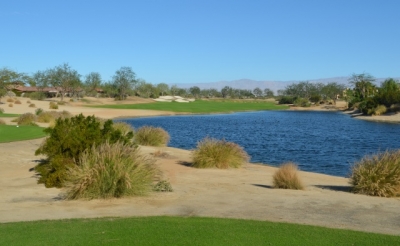 |
| The 9th hole is the shortest par four on the front side, but is still no pushover. |
“Despite the intimidation factor of less turf, everything a player needs to see to make decisions on each hole is right there in front of them on every shot at PGA West.”
Of course PGA West is also known for its tournament history, having hosted the Skins Game, Q-School and the Bob Hope Classic (now known as the Humana Challenge). Did hosting a professional event creep into the equation when laying out the course?
“The owner of the resort back then, KSL, made it clear to us that there was a possibility that the Bob Hope could one day be played on the Norman Course, so yes, we kept that in mind from the beginning,” Campbell explained.
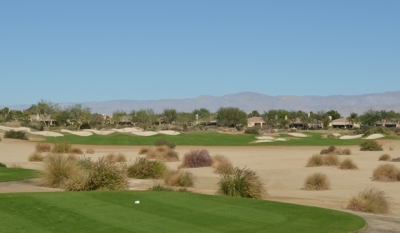 |
| A split fairway greets you off the tee of the par four 15th hole. |
“Greg spent a lot of time considering potential tournament setup options and shot values during his visits, which ultimately created another layer of tournament capability.”
Professionals would no doubt not be bothered too much with fewer grassy areas to play to. They’re more concerned with the enormous bunkers, I’m sure.
Everything is bigger at PGA West. That too, is by design. “The backdrop of the mountains at PGA West is one of the most awesome settings for golf in the world. In fact, the natural surroundings basically force you to think on a bigger scale when you’re out there trying to create something that fits with that environment,” Campbell said.
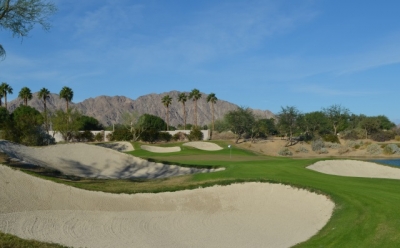 |
| Large bunkers await any misses left on the long par five 8th hole. |
“We spent a lot of time with the construction crew trying to incorporate the same rhythm and slopes that exist in the mountains surrounding the course and the majority of the plants we imported are indigenous to the Coachella Valley.”
The Norman Course lacks the oversized features of the nearby PGA West Stadium Course, though it certainly looks a lot more natural. No railroad ties in view at Norman and there aren’t any plateau fairways like at the Nicklaus Tournament course either.
Again, it’s the rugged look that dominates. In addition to the desert environments, there are water features on half the holes. In other words, there are a lot of different looks on the Norman Course.
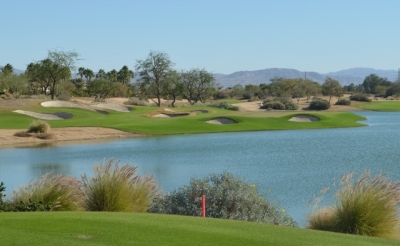 |
| The par three 13th is rated the second toughest hole on the back nine. Here, you see why. |
“I think the entire team did a great job of identifying and creating different landscape zones and habitats throughout the course. If there’s one word I would use to describe the Norman Course, it would be ‘diverse’; from the earthworks and shaping to the landscape and playability…”
“Greg has always said ‘if golfers can remember every hole after their round then we’ve done our job.’”
Mission accomplished. Norman’s personality is definitely embodied in the design. There are a number of risk-reward opportunities that only a player who often took a chance would think to incorporate.
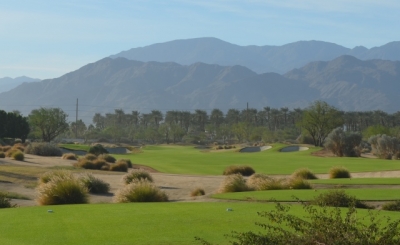 |
| The daunting par four 6th is the number one handicap hole on the Norman Course. |
Campbell agrees. “The Norman Course at PGA West has Greg’s personal fingerprints all over it, but I would have to say the diversity of the playing experience is one of the course’s greatest strengths. To score well requires creativity and the use of just about every club in the bag and I would say that any golfer who plays the course regularly would definitely improve his or her game.”
“During Greg’s visits, he would go back and forth from tee to green several times considering every possible aspect of the design of each hole. That kind of commitment is invaluable, especially when you’re building a resort course that will ultimately host professional events. Greg has a great understanding of golf design and how to put his ideas on the ground and I think that’s evident on our course at PGA West.”
As previously explained, because of the relative lack of turf on the Norman Course, it looks a little intimidating on many holes. Target golf is something you get used to in the desert, but not quite like this.
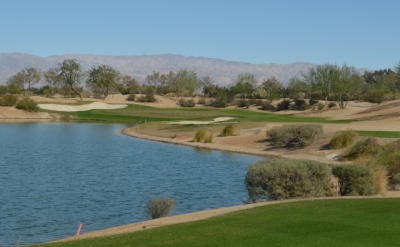 |
| The beautiful par three 17th hole. |
“The course features an abundance of sand, sage, colorful pockets of wildflowers, nine lakes and spectacular panoramic vistas, unmatched anywhere in the Coachella Valley,” said Chad Johnson, General Manager at PGA West.
“There also isn’t any rough on the entire golf course.”
That is unique, for sure. Because the turf is cut down around the putting surfaces, there’s a multitude of options to try and make par if you miss a green. As you would expect, there are slopes and mounds, though not too severe.
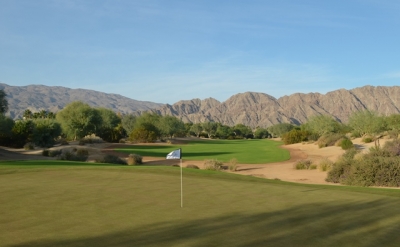 |
| The views from behind many of the holes are just as spectacular as those from the tee. Here, the par five 2nd hole. |
The bunkers are indeed large, but not impossible to extricate yourself should you end up in them.
Wind is always a factor in the desert. It’s usually calm in the mornings, but not on the day we played the Norman Course. The prevalence of water is pretty scary when the wind is blowing towards it.
Five sets of tees provide options on the length you want to take on. The Norman Course measures 7156 yards from the tournament tees down to 5297 from the red tees – again, a lot of diversity. The forward sets take out almost all of the carries, so it’s very friendly to less experienced players and ladies.
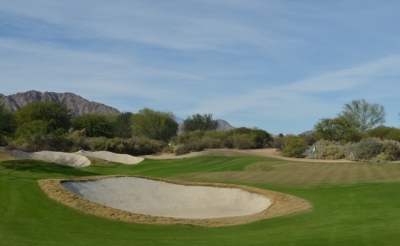 |
| Finishing up on the par four 18th, you will definitely be planning your return to the Norman Course. |
Our favorite holes included the tough par four sixth hole (named Didgeree Doom), which stretches to 481 yards from the back tees. In addition to the length, there are bunkers squeezing both sides of the hole, making the tee shot even more challenging. It’s the #1 handicap hole for a reason.
The long and demanding par five eighth hole (named Wallaby Wallop) is another one you’ll remember. At 615 yards from the back tees, it’s definitely a three-shot hole for everyone but the pros. The fairway slopes towards the water on the right that attracts the second shot -- tee shots must stay towards the left center of the fairway.
Finally, there’s the par three seventeenth hole (named Billabong). “It’s our signature hole that plays to a yardage of 180 yards from the back tees. The tee shot is a forced carry over water and must avoid a greenside bunker on both the left and right,” Johnson said.
The PGA West golf experience wouldn’t be complete without outstanding service. It’s something Johnson says they take pride in. “We strive to make the guest feel as though they just played a private club and are ‘members for a day,’ through our service standards and condition of the course.”
Playing at PGA West isn’t inexpensive (unless you go in the afternoons in the summer, which are actually very tolerable if you drink a lot of water), but it’s a good value for what you receive in terms of quality of golf and memories of playing at a special place.
All in all, a very diverse experience that feels just like you’re in the Outback.
Details:
PGA West Greg Norman Golf Course
81-405 Kingston Heath
La Quinta, CA 92253
Phone: 1-800-PGA-WEST
Website: www.pgawest.com; www.laquintaresort.com
Designer: Greg Norman
Norman’s Project Manager: Chris Campbell
General Manager: Chad Johnson
Tees/Yardage/Slope/Rating
Tournament 7156 139/75.1
Championship 6671 133/72.8
Blue/White Combo 6427 128/71.5
Regular 6227 126/70.6
Gold 5751 120/68.4
Red 5297 112/65.6
Ladies Slope/Rating
White 129/75.4
Gold 123/72.7
Gold/Red Combo 121/71.6
Red 119/70.2
Rates:
Check the websites for rates. Packages are available.
Note: Walking is an option, but likely only in the cooler months.
| Related Links | Comments on this article? | |
|
Maryland National Golf Club Hollow Creek Golf Club Rocky Gap Resort PB Dye Golf Club in Ijamsville Whiskey Creek Golf Club |
E-mail Jeff Rendall, Editor: jrendall@golftheunitedstates.com |












